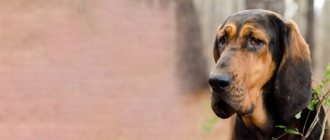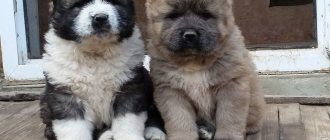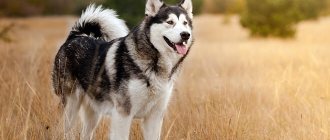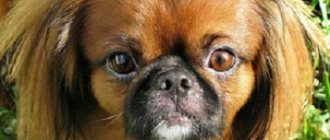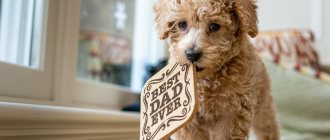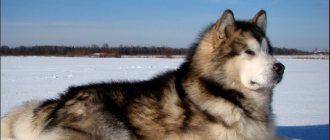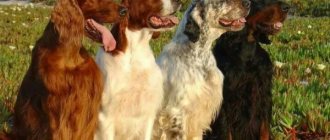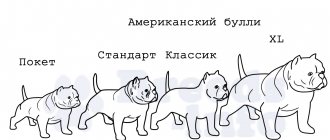Fighting dogs are common among residents of different countries. If you want to buy yourself a reliable bodyguard, the Ca-de-bo (Major Mastiff) would be an excellent option. The breed is known for its large build and its appearance is fearsome. For the owner and his family, dogs are kind, loyal friends, always ready to defend.
Description of the Ca-de-Beau breed
Popularity 21st among 263 dog breeds
Lifespan:
10-12 years
Height:
males: 55-58 cm, females: 52-55 cm
Country of origin:
Spain
Average price:
25-35 thousand rubles
Weight:
from 30 to 38 kg
Latest articles Cat health
Rabies vaccination for cats: choice of vaccine, necessity, schedule 01/22/2022 16 0 0
Selection and adaptation
TOP 20 best cat breeds for families with children 01/22/2022 30 0 0
Advantages and disadvantages
- Pros:
- good security qualities;
- phlegm;
- low shedding and easy care;
- peacefulness;
- calm attitude towards children and other animals;
- affection for all family members.
- Minuses:
- dominant character;
- a small number of nurseries where you can buy a purebred puppy;
- high physical activity requiring walking;
- high cost of maintenance.
Key facts
The name of the breed Major Mastiff, also known as ca-de-bo, hints that the country of origin of these friendly giants is Spain, namely the island of Mallorca. Ca-de-bo means "bull dog".
The description of the Ca de Bou breed emphasizes that the large size of the dog does not allow it to be kept in a small apartment - the best solution would be a country house.
The external characteristics of the Ca-de-Beau, or Major Mastiff, breed are as follows:
- The height of males can reach 60 cm, weight - 40 kg, while females are slightly smaller;
- the breed is popular on the Eurasian mainland, but is almost unknown in America and Australia;
- Despite their “fighting” past, mastiffs have a friendly character and are not overly aggressive;
- The life expectancy of the Ca-de-Beau is 10-12 years, which is considered sufficient for large dogs.
With proper care, a dog can live up to 15 years, but then its health must be carefully monitored. The dog does not cause unnecessary problems if it is carefully trained at a young age. But a spoiled ca-de-bo can become uncontrollable and even aggressive.
How to understand that an animal is losing weight
They try to keep working (hunting) dogs in shape.
For some breeds, thinness is a distinctive feature, so it is not always possible to immediately notice the first signs of weight loss.
The following symptoms will indicate that your pet is having problems:
If a dog's ribs are palpable (although they are not visible through the skin), this is the first sign that the animal has begun to lose weight. However, it may still be in relatively normal physical shape.- If you notice protruding pelvic bones, you need to sound the alarm. This is a dangerous sign indicating health problems.
- If the dog has turned from an energetic dog into a lethargic, apathetic one, it means that it needs to be examined, and weight control must be carried out.
- Wool is an ideal indicator of an animal's condition. As weight decreases, the cover becomes dull. The bristles not only begin to fall out, but the pet becomes bald in places.
A dog that is losing weight can be not only lethargic, but also pathologically irritable. With a sharp decrease in weight, the animal develops shortness of breath, chills, and a rise in temperature. Frequent, profuse vomiting is possible.
The history of the origin of ca-de-bo
Perro Dogo Mallorquin can be called a “dark horse”. The history of dogs of this breed, which began in the middle of the thirteenth century, is accompanied by a trail of their own blood, high mortality of weak puppies and even adult fighting dogs.
It is assumed that the first Molossians (the ancestors of the group of modern mastiffs) appeared on the island of Majorca in the Balearic archipelago due to uncontrolled matings of local dogs. At first, dogs of this breed helped people with cattle driving. Then the villagers noticed the good protective qualities of the animal, making it a guard of houses and numerous maritime warehouses.
Aristocrats liked the appearance of the Ca-de-Beau ancestors, brute strength, good endurance - all these qualities made it possible to use animals during hunting. Boars, bears, and large game were frequent trophies for future Major Mastiffs.
The eighteenth century began with the signing of the Treaty of Utrecht, which stated that Majorca passed into the possession of Great Britain. The cruelty of the English combined with the Spanish thirst for spectacle, and thanks to this, new types of leisure appeared: dog fighting and bullfighting, during which a man went out without a weapon, accompanied by a dog. But the demand for the latter type of “leisure” quickly subsided, since the Perro Dogo Majorquins either killed the bull in the first minutes of the spectacle, or died defending the owner.
The Spaniards were not happy with this state of affairs. A tough selection began: no one cared for weak puppies - they died; people did not vaccinate the Molossians and did not monitor their diet. The bitch who gave birth to them was responsible for raising and feeding them, provided that she survived. Aggressive, cowardly puppies also died from the teeth of their brothers. The continuation of brutal fighting also claimed the lives of dogs: cripples were killed.
The strongest surviving puppies grew into proud, medium-sized dogs that gave birth to healthy offspring. In 1923, the Major Molosser was entered into the Spanish studbook as a Ca-de-Bo. The first representative of the breed was exhibited in 1929.
In difficult times of war, mastiffs remembered their military past, helping soldiers and killing enemy animals. In general, the population did not suffer as much as during indiscriminate bullfighting and hunting.
In 1964, the International Canine Federation created a standard for Major Bulldogs - this happened quite late compared to other breeds. Even after final registration, the dogs were not as popular as German shepherds, Great Danes, and Rottweilers.
Perro dogo Mallorquins received due attention towards the end of the 20th century. Russians and Poles became especially interested in dogs of this breed, while other European and Scandinavian countries showed no attention to them at all; The breed is still not popular in the USA and Canada.
Similar dog breeds
Rottweiler
Cane Corso
Newfoundland
Alaskan Malamute
Tibetan mastiff
Appearance of the ca-de-bo
The purpose of the ca-de-bo is considered to be protection, but the animal can become a devoted pet if properly raised. External strength goes well with a kind and loyal character.
General impression
What does the ca-de-bou look like in photos and in life? The dog is slender and fit, but looks quite massive. The weight and height are average, but the dog looks proportional.
Head
The animal's head resembles a square, characterized by massiveness. The cone-shaped muzzle can be called upturned. The stop is well defined. The high-set, medium-sized ears resemble a rose; when the animal is calm, they are lowered to the line of large, oval, slanting eyes.
The color of the eyes depends on the color of the dog and allows a mixture with darker shades than the coat. The protein is invisible.
The black nose is characterized by well-opened nostrils. The upper lip is tense, while the lower lip is in a relaxed position. The teeth are strong, with an overshot of up to 1 cm.
Neck
The massive neck, well set at the withers, may have a medium dewlap.
Torso
The narrowness of the loin results in a croup that is more square than round. The chest is cylindrical and deep - it reaches the elbows. Widely spaced shoulder blades make the chest visually wider at the withers. The body is muscular and athletic.
Forelegs
The front legs appear parallel. The shoulder joint is moderately short and slightly prominent. One shoulder is parallel to the other. The elbow is loosely attached to the chest, not turned out. The forearm is straight.
The bones are strong, the limbs look muscular. The paws are rounded, the toes form a lump. The pigmentation of the pads and claws is weak.
Hind limbs
The hind legs are parallel. The thigh is wide and curved. The straight hock joint is short. The muscles are more developed than on the forelimbs. The oval legs are more massive than the forelegs. Pads and claws are poorly pigmented.
Tail
The low-set tail is thin at the tip but widens towards the base. A calm dog keeps his tail relaxed; an excited or moving dog lifts it slightly.
Movement
It is typical for the Major Mastiff to trot. The movements are sharp and proud.
Wool
The wool is pleasant to the touch. The hairs are short, tightly adjacent to each other.
Color
The most advantageous color for Ca-de-Beau to participate in exhibitions is considered to be deep red (brindle, fawn), but black is also allowed. White spots on the face, chest and limbs are allowed. The presence of a mask on the face is not a disqualifying defect.
Size
The Perro Dogo Mallorquin puppy is born small, but by the month it gains up to a kilogram in weight. The height and weight of Ca-de-Beau in adulthood depends on the conditions in which the dog grew up, the quality of food and gender - boys are heavier than girls.
The height at the withers, that is, the height of the ca-de-bo reaches 55-58 cm in a male, weight is 35-38 kg; the female grows to 52-55 cm and weighs from 30 to 34 kg. A slight increase in weight is allowed while maintaining a harmonious appearance. The size of the ca-de-bout is not a priority when evaluating judges; the main condition is proportionality.
Character of the ca-de-bo
Under the thick skin with pleasant, but slightly prickly fur, hides a kind and sensitive heart. The character of the Ca-de-Beau next to a skilled owner-trainer is flexible; by nature, dogs are phlegmatic. Aggression, attributed to an animal because of its appearance, can manifest itself in the event of unsuccessful socialization by the puppy at home or lack of upbringing.
They tolerate forced loneliness calmly - you won’t find any wild barking, no howling, or tattered furniture upon your return. The Major Mastiff cannot be called an overly active dog: he does not like long walks on the street. But being in a good mood and accompanying its owner, the animal can happily walk for many kilometers both in winter and in summer.
Who is the Major Mastiff suitable for? Due to its excessive tendency to dominate, the mastiff is not suitable for inexperienced and too soft dog breeders - this is perhaps the only limitation. Ca-de-bos are owned by young families and retirees who are able to take care of a dog in strong hands.
As soon as he finds himself in a new house or apartment, the dog wins the attention of each family member and gives them equal portions of affection. Perro dogo Mallorquin loves to play with children, gets along easily with other animals and rarely shows displeasure towards them.
If you get a dog of this breed, get ready for the fact that your life will change in a positive direction: the familiar world will take on bright colors.
Lack of nutrition
The most obvious conclusion that in many cases one would like to draw is poor feeding of the animal. Lack of nutrients is a serious reason for weight loss. In this case, the animal begins to gradually “melt before our eyes.” It happens that a person believes that on his part he is doing everything necessary to feed his four-legged pet. If you start to understand this issue more deeply, it turns out that he feeds the pet not at all high quality: table scraps, dry cheap food.
Therefore, it is not surprising that the dog is thin. After all, it is important not only to feed your pet, but also to do it correctly. A lack of nutrients in the body always has a negative impact on well-being and appearance.
Education and training
The Major Mastiff, despite its phlegmatic character, needs a responsible owner who can create competent training programs. But not everything depends on the owner: primary socialization takes place in the nursery where the puppy was born, so it is important to be confident in the integrity of the breeder.
Raising and training Ca-de-Bo should begin at two months, in particular, from the moment when the animal first finds itself in a new home. It is important to show the puppy the internal “hierarchy” and the boundaries of what is permitted.
It wouldn’t hurt to communicate with older, well-mannered and trained four-legged friends. Training should become more difficult in proportion to the age of the animal. Carefully practice the desired habits, since they can be easily corrected only in the first year of the animal’s life - during the most active period of brain development.
The little Great Dane often rebels, testing the owner's strength: he chews furniture, goes to the toilet on the carpet, or does something similar. Owners, frightened by such behavior, take the animal to a dog handler. But everything is simpler: the animal simply tests the owner’s endurance.
It is recommended to take the obstinate dog to group classes, where he can meet more well-mannered dogs and learn the basics of good behavior. The ideal solution would be to attend OKD or UGS courses.
Looking for a ca-de-bo? Find your pet from 1 offer Buy
Veterinary examination
It is necessary in order to exclude any pathologies in the body. A full veterinary examination is not very cheap. But it allows you to understand the state of your pet’s health.
If it has been noticed that the dog is losing weight for no good reason, a full diagnosis needs to be carried out. Only in this case will it be possible to understand the situation. Without an examination, nothing can be determined. Old animals lose weight, despite proper care and timely intake of special supplements. Dogs are very sensitive to various changes in their health. The more attention they receive, the better.
Health and illness Ca-de-Beau
Due to the low survival rate of weak individuals in the past, modern Major Mastiffs are very healthy, and the number of genetic diseases characteristic of them is small. Vaccinations against serious diseases are given to puppies while still in the kennel, but every year the protection should be updated by revaccination.
An active lifestyle and good nutrition are important to prevent obesity. It is necessary to carry out daily toileting (especially during the molting period, because the animal may begin to itch severely due to itching from crawling fur, which will be especially noticeable on the face), monitor the condition of the oral cavity and brush its teeth at least twice a month - to prevent the appearance of tartar.
Possible diseases
Mostly, dogs from Mallorca have problems with the gastrointestinal tract, musculoskeletal or cardiovascular systems:
- allergies to food (individual intolerance to any element manifests itself as a rash on the skin, redness of the eyes, and unpleasant odor from the ears);
- hepatopathy is a general name for a number of liver diseases;
- myositis - the disease is an inflammation of the muscles;
- hip dysplasia.
Due to stress, dermatitis, other diseases of the skin and coat, and stomach problems can occur. Most ailments can be treated if you visit a veterinary clinic in a timely manner.
Reproductive health
Pregnancy and childbirth of the Major Mastiff proceed safely if several rules are followed. Firstly, mating cannot be carried out during the first heat, when the bitch’s body has not yet fully formed. Secondly, it is necessary to provide the animal with everything necessary - medical care, good nutrition, a favorable atmosphere to prevent the development of stress. Thirdly, care should be taken to create good conditions for future offspring, because after birth, puppies must live in the breeder’s house for some time.
If the dog owner is not sure that he will be able to bear the corresponding costs, the dog can be sterilized. The life of the owner and the bitch will be simplified significantly - there is no need to worry about dirty furniture and unwanted matings during escapes.
Causes of pet exhaustion
The dog eats well, but at the same time loses weight, often due to improper nutrition. This can be caused by various factors:
The animal’s food needs have increased, and they are associated with the following points:- the pet is too active and wastes energy on movements;
- pregnant and lactating dogs require increased nutrition;
- The puppy is growing quickly and needs high-calorie food.
- Low-calorie food.
- Unbalanced diet and lack of calories, but the dog has a good appetite and eats a lot.
- A sudden transfer to a different diet: the dog may begin to lose weight due to stress or even refuse unusual food.
- Extreme heat: The dog eats less well, but drinks a lot of water and can still remain active.
Dietary problems can be easily fixed. But if, after adjusting the diet, the owner notices that the dog continues to lose weight, one should look for internal reasons.
Why does a dog lose weight?
| Factors | Description |
| Gastrointestinal diseases | Poor quality nutrition can provoke the development of gastritis, pancreatitis, colitis, and stomach ulcers. |
| Infestations | Even with a balanced diet, sudden weight loss is observed if helminths have settled in the body. Their presence can lead to volvulus. In this case, the dog does not eat anything, and its belly is large |
| Wounds in the mouth | If your pet doesn’t eat well or refuses food and drinks a lot of water, you should look into its mouth; it may have broken teeth, damaged palate or larynx. |
| Ear problems | Infectious diseases affecting the hearing aid make chewing difficult |
| Viruses | The animal may become ill with adenovirus or hepatitis. To exclude these diagnoses, any rapid weight loss in your pet should be examined. |
| Allergy | Both harmful environmental elements and an allergic reaction to new products can lead to the problem. |
| Oncology | Sudden weight loss with refusal to eat may be a sign of the development of cancerous tumors |
Sometimes dogs end up on the operating table, and after anesthesia have difficulty returning to their usual diet.
This situation is considered normal if it lasts 2-3 days. Stable dynamics of weight loss lasting more than five days should alert you. Perhaps the surgical intervention disrupted some processes in the body.
If a dog has gone on a hunger strike and is wasting away before our eyes, it should be taken to the veterinarian immediately. An animal that is not vaccinated in a timely manner can develop a dangerous disease – distemper.
Features of feeding and diet
Ca-de-bo nutrition is a frequently discussed issue on forums. If the owner does not have the opportunity to visit a doctor or consult a canine specialist, then you can read the guide on feeding a puppy or an adult dog written about this breed.
The basis of the diet can be natural food or dry food. In any case, the norms for the intake of proteins, fats, carbohydrates and calories must be observed, and the health characteristics of the animal must also be taken into account.
The number of feedings and the size of portions depend on the age of the individual. A one-month-old puppy should receive small handfuls of food six times a day, a five-month-old baby should receive three small portions, and an adult dog should receive two fairly large portions.
Natural nutrition is the most difficult to “execute” due to the need to constantly monitor the quantity and quality of nutrients entering the body. On this type of diet, the mastiff can be given the following food groups (mainly of animal origin):
- lean red meat;
- poultry meat (chicken, turkey);
- rabbit meat;
- offal;
- low-fat sea fish, boneless;
- fruits, berries (except for fruits with seeds and citrus fruits);
- vegetables (peas, cabbage, beans are excluded);
- vegetable oils;
- fermented milk products with a low fat content;
- whole grain crops.
The dry type of food involves feeding one type of food (necessarily premium, since cheaper analogues often contain substances harmful to the dog).
The owner decides what food to feed the dog: after moving to a new home, for one month the puppy eats the same food as in the kennel, and then the owner can change it. It is important to choose the right food so that it covers the dog’s energy costs and maintains its appearance in proper condition. If the animal has undergone medical intervention or acquired a chronic disease, the veterinarian selects food adapted to the new needs of the body.
Vaccinations
For the health of the dog, the owner is obliged to take preventive measures in a timely manner. One of these important steps is vaccinations. They need to be done regularly to eliminate possible unpleasant consequences. It would be wisest to consult a specialist about how often they should be placed and at what time. Vaccinations prevent the development of many diseases and reduce the risk of infection several times. If your dog has noticeably lost weight, it would be a good idea to pay attention to this point.
Care and maintenance
Care and maintenance of a ca-de-bo implies the presence of either a large apartment or a country house - due to the large size of the animal. The minimum necessary for a comfortable stay will be a large warm bed in a well-ventilated but not cold place, a small number of toys, freely available food and water.
The Mastiff does not need to be entertained intensely - its character allows you to leave the animal alone for a long period of time without dire consequences for the home. Only competition animals need grooming, but if the owner wishes, any animal can be groomed by a professional.
How to care for a dog of this breed? Major dogs are not a long-haired breed, so caring for them can be called simple. The coat does not need daily brushing (except during shedding periods). It is recommended to carry out thorough washing no more than twice a month, so as not to wash off the natural protective layer from the hairs.
Claws are trimmed in winter, when the animal does not have the opportunity to grind them off on the asphalt on its own. Due to the pink-like shape of the ears, they should be treated quite often - this will help protect your pet from parasites.
A separate topic is oral care - brushing your teeth should become a weekly ritual, which will prevent the appearance of caries and tartar. Plaque in representatives of this breed occurs quite often due to the structural features of the jaw.
Timely deworming
It allows you to avoid many unpleasant consequences that may inevitably arise if you do not follow important rules. A very important factor is deworming of all pets, regardless of their appearance and feeding methods. It should not be neglected, hoping for a lucky break. After all, life can be quite unpredictable; we are not always able to predict the development of events in advance. Preventive treatment of animals should be carried out, as noted above, once every three months. If helminths are found in the animal, the medicine is given immediately. After two weeks, the drug is repeated. Antihelminthic medications are also given to animals two weeks before vaccination. A person must take responsibility for his pet. A dog always feels when he is cared for. You can be sure that she will answer you in kind.
Tips for choosing a puppy
Dogs of this breed are unpopular in Russia (which affects the price), so the first step in choosing a puppy - finding a good kennel - may seem difficult to implement. Most sellers are located in cities of federal significance, the Moscow region (for example, in Domodedovo), but if you really want, you can find options in the regions - Yekaterinburg and Dmitrov.
The second point is to meet the mother bitch and, if possible, the father dog. This way the future owner will be convinced that the adult dogs are healthy and fit. You can ask for documents to familiarize yourself with their pedigree, the reality of the assigned titles and a health certificate.
The third point is the actual choice of the ca-de-bo puppy itself. The baby should be active, inquisitive, and friendly. A healthy animal will not limp, whine or lie down for a long time. Shiny coat, normal-colored mucous membranes, soft belly are indicators of physical health. If at this stage there is no confidence in your own abilities, you can consult a dog handler (the cost of this service is low).
Ka-de-bo are animals interested in building trusting relationships. Small males are not as flexible as females, but all kids want to find a loving owner. It is advised to pay attention to the animal that reacted vividly to the appearance of a person.
How much does Ca-de-Beau cost?
The cost of the animal depends on the region where the nursery is located, the conditions created there (money spent on maintaining the bitch, from pregnancy to the postpartum period, on food for puppies, veterinarian examinations, consultations with dog handlers), titles assigned to the parents, the class of the animal (pet class costs less than show class). If the buyer is in another area, the cost of transporting the animal should be taken into account.
Dogs are divided into classes based on their ability to participate in breeding:
- pet class
– the animal is not allowed to be bred due to the presence of serious defects in appearance or character; participation in exhibitions is also impossible, the cost is about 15 thousand rubles;
- breed class
– the most numerous category of domestic animals, in the appearance or character of which there is one minor flaw; their participation in exhibitions and breeding is possible, the cost is in the range of 25-35 thousand rubles;
- show class
– puppies of this category remain with the kennel due to the fact that their appearance and character are good; participation in exhibitions will most likely bring first place, the cost starts from 40 thousand rubles.
When purchasing, make sure your baby has a puppy certificate, which in the future can be exchanged for a pedigree, and a veterinary passport with notes on completed vaccinations. The presence of these documents indicates the seller’s integrity and the justified price of the ca-de-bo.
In some cities you can purchase a mastiff puppy from an advertisement on the Internet at an attractive price, but in this case no one can guarantee the purebred and adequacy of the animal.
Do you like the article? 0
Gaining weight for competitions
If there is an exhibition coming up, and the pet’s parameters do not meet the standards, reduce physical activity and increase the amount of food. Avoid drastic changes in your diet. Show class animals are admitted to the competition only after careful selection. Having access confirms the high quality of their content. Sudden changes can lead to deterioration in coat quality and allergic rashes. Even if you achieve the required kilograms, the prize place will still remain unattainable due to deviations in more serious indicators.
If your pet is going to compete in agility competitions, hunting or other super active activities, it is necessary to increase the calorie content of the food. Each individual breed has its own standards, and a specialist will tell you about them. A well-designed menu is the key to success for a four-legged competition participant.
Dystrophy is fraught with very serious complications. Don't let the situation take its course and seek help at the first signs of weight loss. In most cases, the owner is to blame for malnutrition, so read the recommended feeding rules and regulations for a specific breed before purchasing a pet.
The article is for informational purposes only. Contact your veterinarian!
